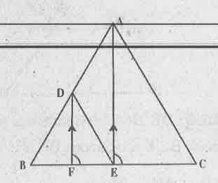క్రింది సమితులలో ఏవి పరిమిత సమితులో , లేక అపరిమిత సమితిలో పేర్కొనండి. {x : x ∈ N మరియు x2=4}
Step by step video & image solution for క్రింది సమితులలో ఏవి పరిమిత సమితులో , లేక అపరిమిత సమితిలో పేర్కొనండి. {x : x in N మరియు x^(2)=4} by Maths experts to help you in doubts & scoring excellent marks in Class 10 exams.
Updated on:21/07/2023Topper's Solved these Questions
Similar Questions
క్రింది వాటిలో ఏవి సమితులు? మీ సమాధానాన్ని సహేతుకంగా సమర్థించండి. "J" అనే అక్షరంతో ప్రారంభమయ్యే ఒక సంవత్సరంలో గల అన్నీ నెలల సమూహాలు.
View Solutionఘటన E యొక్క సంభావ్యత + ఘటన E కాదు సంభావ్యత =..............
View Solutionఇచ్చిన పటంలో, DE∣∣AC మరియు DF∣∣AE అయిన BF /FE = BE/ EC అని చూపండి.

View SolutionCoefficient of x(n^(2)+n-14)/(2) in,(x-1)(x^(2)-2)(x^(3)-3)(x^(4)-4)......(x^(n)-n),(n>=8) is
View Solutionf(x)=lim_(n rarr oo)((n^(n)(x+n)(x+(n)/(2))...(x+(n)/(n)))/(n!(x^(2)+n^(2))(x^(2)+(n^(2))/(4))......(x^(2)+(n^(2))/(n^(2))))) foe all x>0. Then
View SolutionThe coefficent of x^(n) in the expansion of (1+(x^(2))/(2!)+(x^(4))/(4!)+…)^(2) When n is odd is
View SolutionIf 4x⋅n2=4x+1⋅n and x and n are both positive integers, what is the value of n?
View SolutionFind the coefficient of xr in the expansion of
(x+4)n+(x+4)n−1(x+3)+(x+4)n−2(x+3)2+.....+(x+3)n
View Solutionमाना कि सभी x>0 के लिए है f(x)=limn→∞⎛⎜ ⎜⎝nn(x+n)(x+n2)....(x+nn)n!(x2+n2)(x2+n24)...(x2+n2n2)⎞⎟ ⎟⎠xn है | तब
View Solutionకింది బాహుపదులలో P(0),p(1)మరియుp(2)విలువలుకనుగొనుము.p(x)=x^(2)-x+1
View Solutionp(x)=x^(2)-x-6 అనే బహుపదికి 3 మరియు -2 అనేవి శూన్యలు అగునో, కాదో సరిచూడండి.
View Solutionp(x)=x^(2)-5x+6, q(x)=x-2 మరియు r(x)=0 అయిన g(x)=
View SolutionS = {x,x అనేది 2n + 3, nవ పదంగా గల అంకథ్రేఢిలోని పదము, మరియు n<6) అయిన S=
View SolutionA={x / -1 le x le 1}, f(x) = x^(2), g(x) = x^(3)గానిర్వచిస్తేకిందిప్రమేయాలలోఏవిసంగ్రహిస్తాయి?f : A rarr A
View SolutionA={x / -1 le x le 1}, f(x) = x^(2), g(x) = x^(3)గానిర్వచిస్తేకిందిప్రమేయాలలోఏవిసంగ్రహిస్తాయి?g : A rarr A
View SolutionIf n is odd, then Coefficient of xn in (1+x22!+x44!+....∞)2=
View Solution
